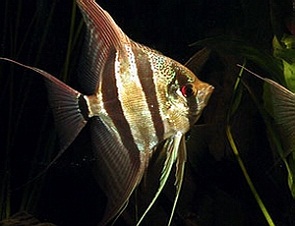Common Name:
Angelfish
Overview:
Perhaps the most popular Tropical fish is the angel it can be the showcase of any aquarium. The different color varieties make it one of the most varied species available. Often sold very young and small it must be noted that they do grow large and need a fairly large fish tank to house them properly.
Distribution:
Amazon region
Coloration:
The body is Silvery with a slight Brown tinge, the snout, back and forehead are Brownish Yellow. Sides are marked with four Black transverse bars, the first running in a curve from the nape through the eye to the start of the Ventral fin, the second from the Dorsal to the anus, the third is the most prominent runs from the Dorsal to the Anal fins and the fourth crosses the start of the Caudal fin. A few fainter bars can sometimes be seen in the upper half of the body. The Dorsal fin spines are Yellow-Brown, the front of the Ventral fins Steel-Blue and the soft rayed parts of the unpaired fins are Grayish-White.
The above paragraph was a description of the original wild caught specimens and is seldom seen in its true colors anymore. Today Angels come in all color varieties and more are added almost everyday. There are Black, Gold, Ghost, Marble, Veiltail and many more available today. All are the result of color and fin mutations through selective breeding.
Care:
Angelfish can survive on flake food alone, but they will thrive and be much more apt to breed on a greatly varied diet. Live foods such as Adult Brine Shrimp, Black Worms, Mosquito larvae, finely chopped earthworms and Guppy fry are accepted with enthusiasm and should be included regularly. If live food is not available, frozen packages of Blood Worms (Midge Fly larvae), Brine Shrimp and others are available from your favorite pet supply store and are acceptable substitutions for the live food. There are many dried foods available that will suffice too. Raw beef heart, finely ground, mixed with unflavored gelatin and frozen immediately in small one serving size pieces is a good and economical addition to your Angelfish diet. Be absolutely sure there is no fat in the meat
Live plants should be included in all freshwater tanks. Water quality is monitored by live plants as they will look sickly before the fish die, they aid in keeping water clear, hinder growth of algae and add Oxygen to the water. Broadleaf aquatic plants are favorites of Angelfish for laying their eggs on. Amazon Sword Plants (Echinodorus) are in a genus that embraces more than fifty relatively hardy and adaptable species, most of which are native to the flood plains of South America. They prefer water that is neutral or slightly acid and not too hard making them perfect plants for your Angelfish tank. Vesicularia dubyana (Java Moss), Ceratopteris (Water Sprite) and Microsorium (Polypodium pteropus or Java Fern) are all compatible live aquatic plants..

